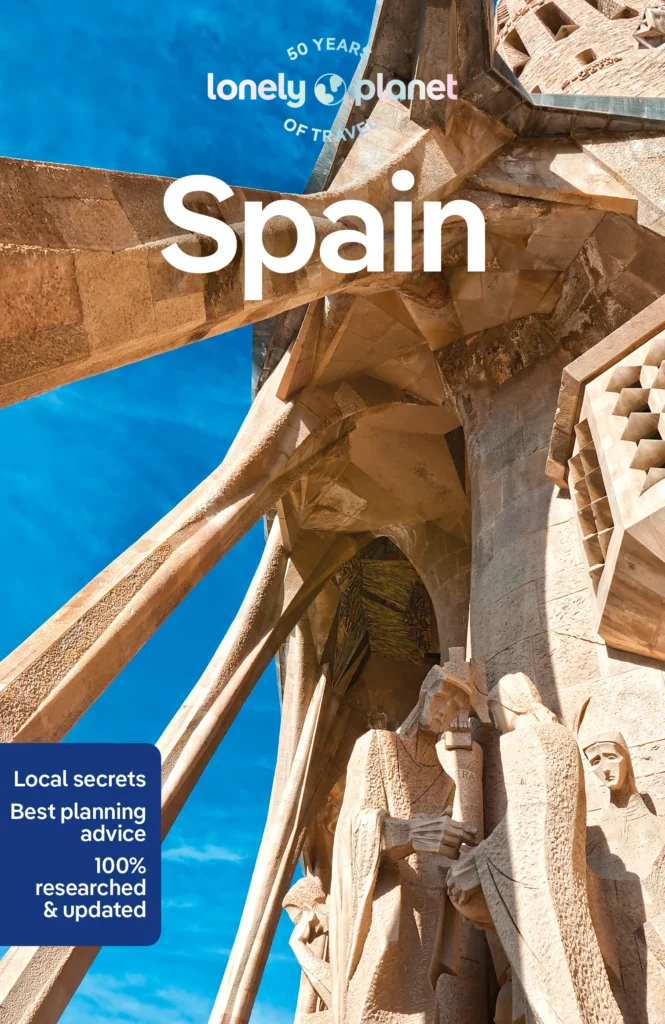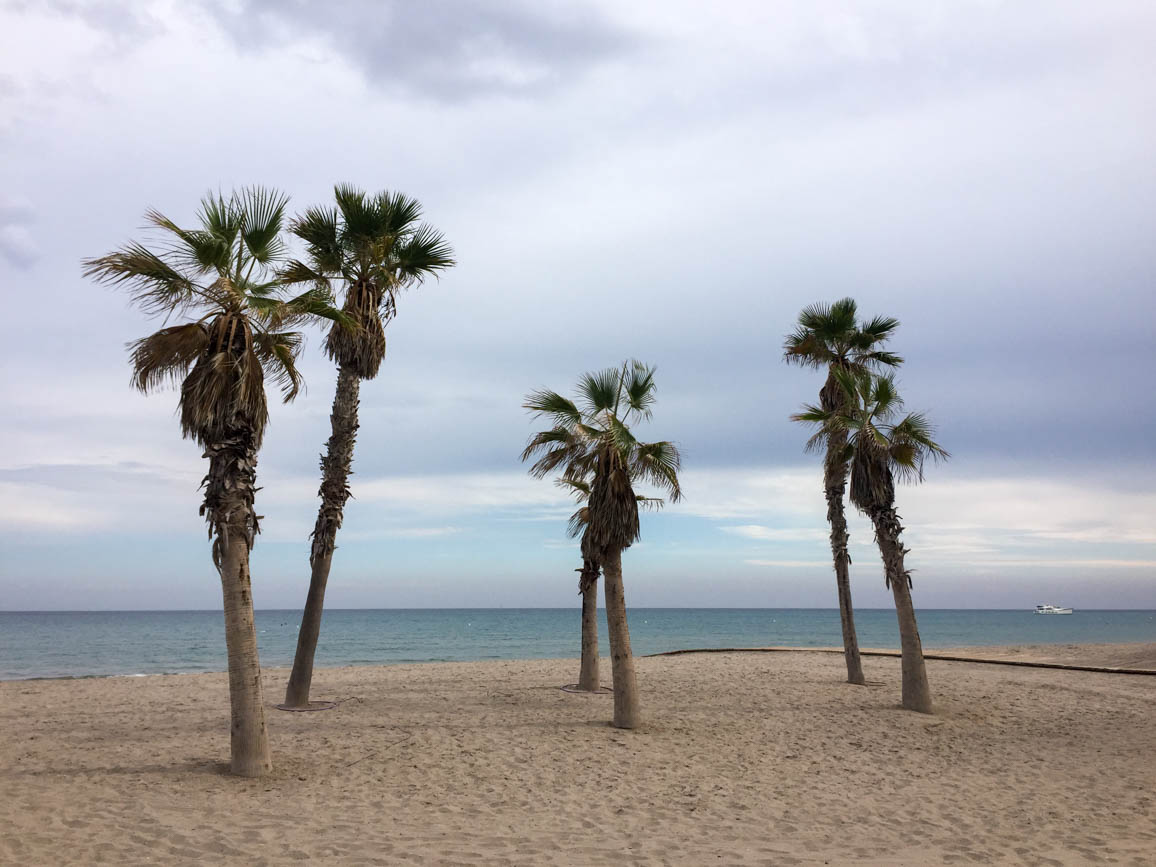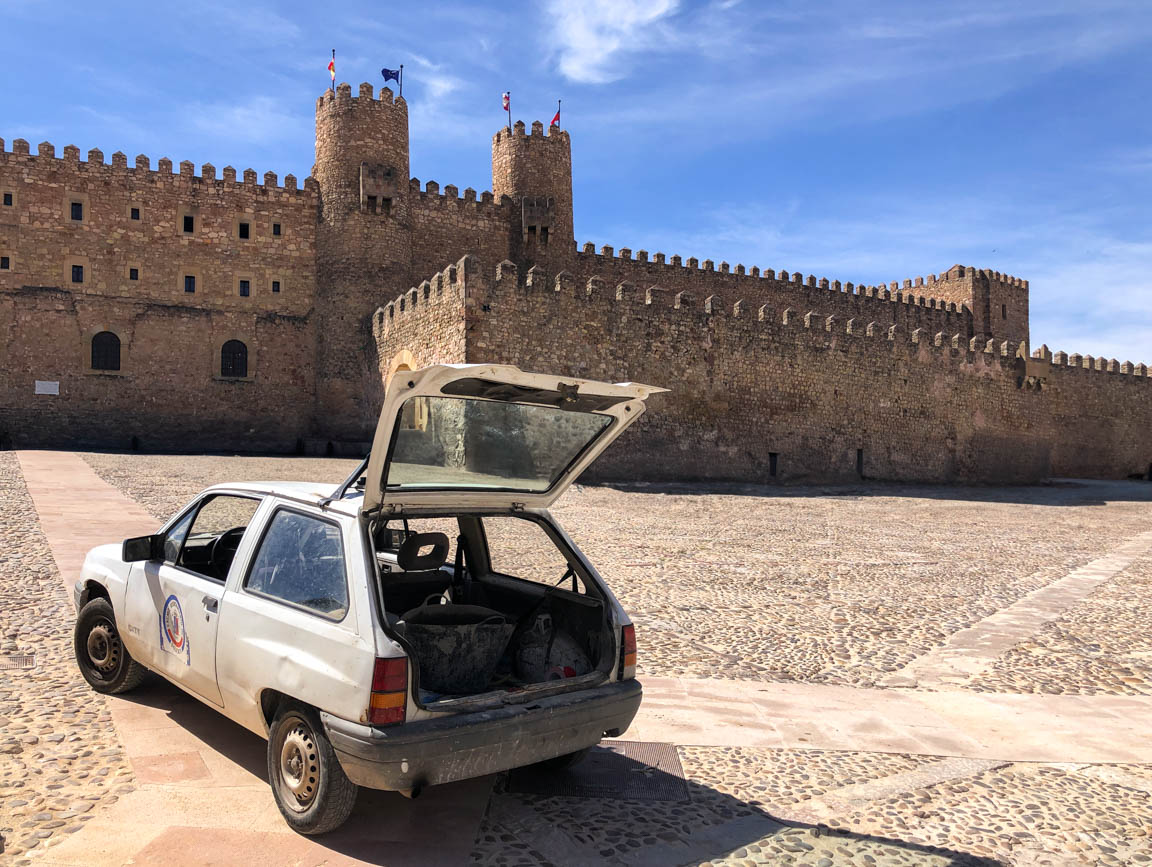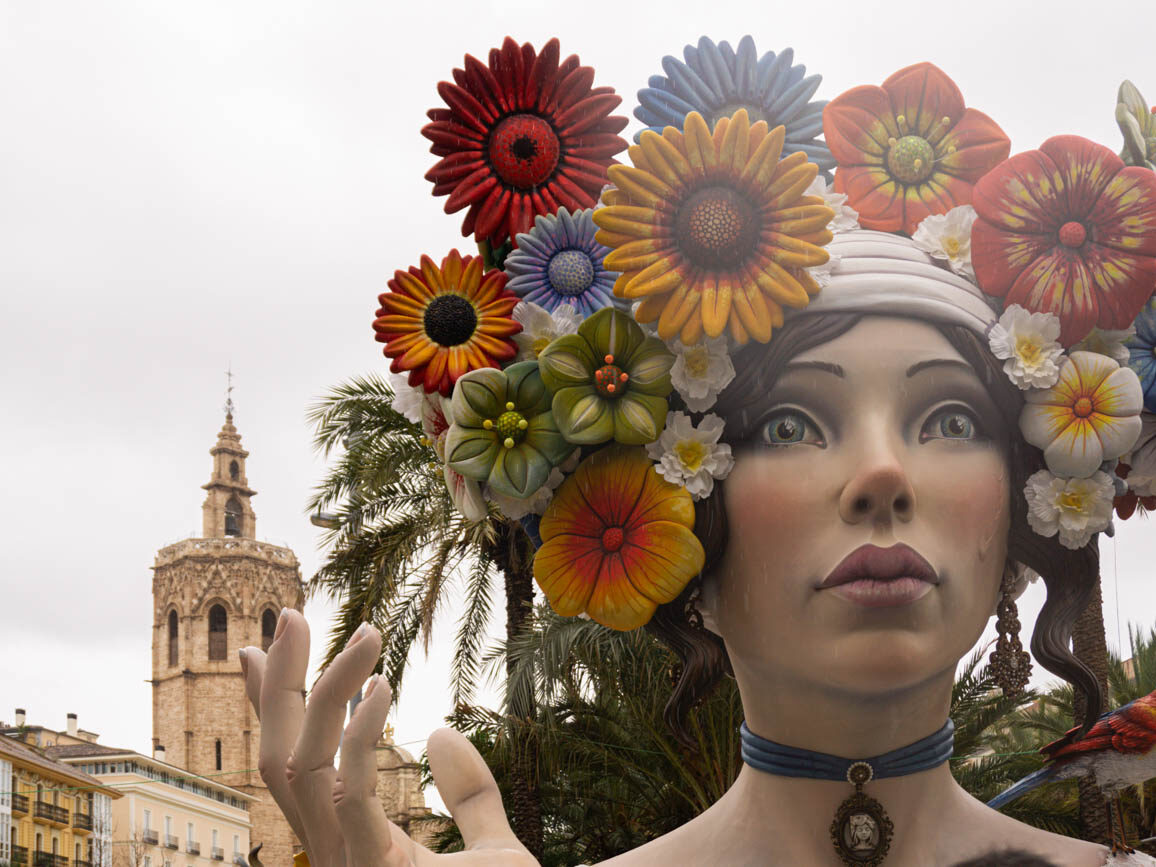
Las Fallas festival in Valencia (2025 guide): what to see, do and eat
Each year during the first half of March, Valencia becomes an exuberant city with grand firecrackers and firework displays, towering satirical figures and loud music bands at every turn. This traditional festival is known as ´Las Fallas´ and if you happen to be in town during those days, you´ll quickly notice that this is a unique opportunity to experience the rich culture of the Valencian Community. Want to know more about this authentic celebration? Then keep on reading this travel guide about the Fallas in Valencia (Spain), based on my personal experience, to help you understand and navigate this festival like a local.
***
- Disclaimer: please note that this post includes some affiliate links. This means that, at no additional cost for you, I earn a commission if you make a purchase. In case you have any question about the companies advertised here or my status as an affiliate, please do not hesitate to contact me.
- Should you want to get a glimpse of my stay at the Fallas of Valencia, you can check out my Instagram reels and posts (post 1, post 2).
***
Throughout the trip, I used this Spain travel guidebook by Lonely Planet to plan my stay and make the most out of it. I hope you’ll find it helpful too!
What you need to know about the Fallas 🧨
Held every March, Las Fallas (or les Falles) is Valencia’s most famous festival and also one of the most spectacular in all of Spain, mixing traditional art and music, fire, explosions, and attracting visitors from all over the world.
You will soon find out that locals in Valencia (and across the Valencian Community in general) love noisy celebrations and setting things on fire. That is why firecrackers, fireworks or bonfires (‘hogueras‘) are highly popular in this region.
Before going into my own experience at the Fallas in Valencia this year, let me start with some basic facts about this traditional celebration, from what they are exactly, to when and where you can find them, why they became such a big thing or who is who. I will then share what you can do and eat in the city during this busy period. Last but not least, I´ll walk you through the top things you can do in Valencia and suggest a few day trip ideas from this Mediterranean destination.
To help you navigate the endless events happening during the Fallas, feel free to use this cheat sheet.
| FALLAS EVENT | DATE | TIME | LOCATION |
|---|---|---|---|
| Crida (announcement of the Fallas) | Last Sunday in February | 19h30 | Torres de Serranos |
| Mascletá (pyrotechnic show of firecracker detonations) | March 1-19 | 2pm | Town Hall Square (Plaza del Ayuntamiento) |
| Cabalgata del Ninot (satirical parade) | March 1st | Starts at 17h30 | Glorieta in Plaza Alfonso el Magnánimo, calle La Paz, San Vicente, Plaza del Ayuntamiento, calle Xàtiva |
| Plantà (the fallas are finally assembled and placed throughout the streets of Valencia) | March 15 | During the day | Throughout the city of Valencia |
| L’Albà de les Falles or Nit de L’Albà (fireworks to celebrate the plantà) | March 15 | At midnight | Plaza del Ayuntamiento |
| Despertà (the Fallas commissions wake up the city with firecracker detonations), inspection of the fallas award ceremonies | March 16-19 | Early in the morning | Throughout the city of Valencia, but the award ceremony takes place in the Town Hall Square |
| Ofrena de Flors (floral tribute to the Virgin and patron saint of the city) | March 17 and 18 | From 3.30pm until midnight | Plaza de la Virgen |
| Nit del Foc (grand firework display) | March 18 | At midnight | Around the nearby Palau de Les Arts Reina Sofia |
| Last mascletà, Cabalgata del Foc (a light, fire and gunpowder show) and cremà (all the fallas monuments are set on fire) | March 19th | Last mascletà at 2pm, Cabalgata at 7pm, cremà starting at 8pm | Mascletà in Plaza del Ayuntamiento. Cabalgata del Foc along Calle de Colón and cremà throughout the city of Valencia |
What are Las Fallas? 🎉
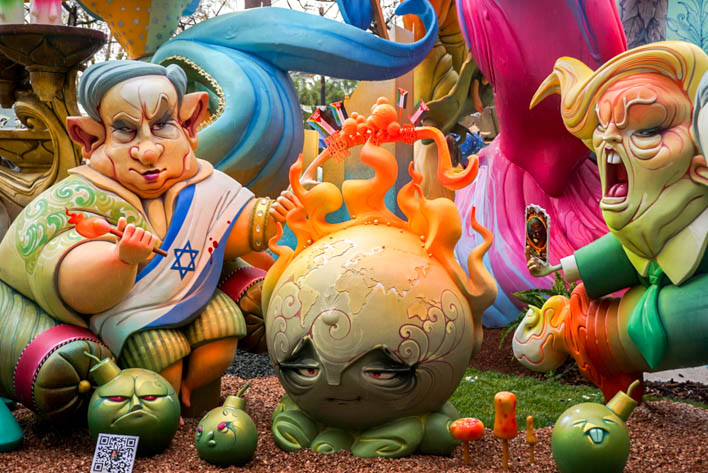
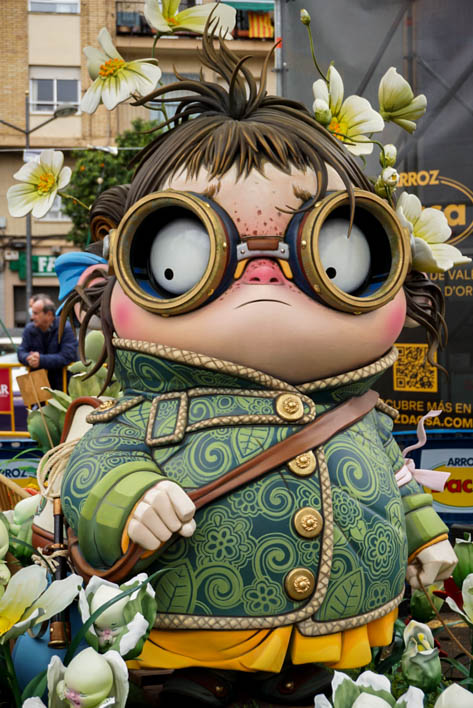
The term ´falla´ (or ´fallas´ in plural) refers to a large satirical sculpture or monument made up of cardboard, wood or polyurethane individual figures (called ninots) created by local artists and craftspeople that provides a commentary on current social or political issues, be they local, regional, national or even international. Their construction typically takes a whole year and costs thousands of euros.
Las Fallas can both refer to the imposing handcrafted monuments themselves or to the festival celebrations in general.
To give you an idea, you can find up to 800 fallas in Valencia every March! What is more surprising is that the herculean effort of creating and assembling them comes to an end every year on March 19th, when all Fallas are burned to the ground during the cremà (except for the ninot indultat, the figure which will be pardonned and transferred to the Museo Fallero). As soon as the celebrations are over, the Fallas commissions start from scratch all over again, thinking about the festival next year. It´s truly short-lived!
In fact, not all fallas are created equal, and as such, there are various categories called sections (Secciones), ranging from the Special Section (known as Sección Especial and made up of those with the largest budget and size), to the Large Section (Sección Grande), the Children´s Section (Sección Infantil), First A Section and so on. There are up to 20 different sections in total. However, the most important Fallas are those competing in the Special Section (Sección Especial) as well as the one from the City Hall (Falla del Ayuntamiento). The latter is actually not part of the competition because locals consider that it belongs to the entire city, to all Valencians.
You should know that, in addition to being a festival, the Fallas are also a competition rewarding the best monuments, from the most ingenious and funny, to the street lighting or their ninot indultat. The prizes are awarded by category to the corresponding comisiones falleras on March 16th and 17th. Winning the first prize of the Special Section is an honor equal to being the best falla of Valencia.
Basic glossary to get around Valencia in Fallas
During this festival period, there are certain Valencian words you need to be aware of to navigate the Fallas like a local:
- Casal faller: it refers to the place where the members of a falla commission get together to decide about their falla monument and celebrate during the Fallas festival.
- Comisión Fallera: these commissions bring together a compact human team (falleros and falleras) comprising all those who want to work side by side for a whole year so that the fallas of their neighbourhood or association can be held. Typically, each commission works on both a large and a children´s falla (known as falla grande and falla infantil).
- Cremà: setting fire and burning a falla monument, typically on March 19th.
- Crida: this proclamation marks the opening of the Fallas festival in Valencia and takes place in the historic Torres de Serranos in El Carmen neighborhood. They are followed by fireworks.
- Despertà: happening every morning during March 16-19, the various Fallas associations wake up the city with firecrackers such as the ´tro de bac´, the most popular pyrotechnic device.
- Falla: as mentioned earlier, it’s a large satirical sculpture or monument made up of cardboard, wood or polyurethane ninots created by local artists and craftspeople that provides a commentary on current social or political issues. There are various categories of fallas, with the most important ones being those from the City Hall and those belonging to the Special Section. Only one ninot is pardonned (‘ninot indultat‘) every year, meaning it won’t be burned down as the others. Should you wish to learn more about this rooted local tradition, you may visit the Museo Fallero or La Ciutat Fallera.
- Fallera: girls and women representing their neighborhood or association. They are dressed with voluminous gowns typically made of silk or embroideries, and style their hair with elaborate buns.
- Mascletá: happening every day at 2pm from March 1st to March 19th, head to the Town Hall Square (Plaza del Ayuntamiento) to experience this noisy pyrotechnic show of firecracker detonation and thunderous sound first-hand. Gunpowder takes over every corner!
- Ninot: individual caricature pieces which are part of a larger falla monument.
- Nit del Foc: literally meaning the night of fire, this grand firework display on March 18th precedes the last day of the Fallas celebrations.
- Ofrena de Flors: this traditional event takes place on March 17 and 18. The Fallas commissions from Valencia and the entire province make an offering of flowers to the Mare de Dèu del Desamparats, better known as the ´Geperudeta´ or ´la Mareta´. The flowers are placed on a large wooden structure with the image of this virgin, thus creating a delicate cape.
- Plantá: it refers to the moment a falla is erected, since these monuments are typically built in a workshop and then placed throughout the city of Valencia.

When does the Fallas festival take place in Valencia? 🗓
If you happen to visit Valencia during the first half of March, make sure to enjoy this vibrant and traditional festival. Fallas de Valencia are celebrated every year on the eve of the spring solstice in honor of Saint Joseph (San José).
Although the key dates are concentrated during the Fallas week of March 15-19 (known as Semana Fallera), the preparations start literally months earlier. For example, the various fallas need to hire the artist who presents a more suitable sketch for the ephemeral monument, distribute the work internally or elect their Fallera Mayor as well as their Courts of Honour.
To help you navigate this festive period, here´s your Fallas calendar, broken down by day:
- Last Sunday in February: taking place in the historic Torres de Serranos, a large number of falleros come together to announce that the Fallas festival is around the corner. This event is known as crida, and it is then followed by fireworks.
- March 1-19: happening every day at 2pm, the mascletá is a noisy pyrotechnic show of firecracker detonations taking place at the Town Hall Square (Plaza del Ayuntamiento). For this event to begin, the Fallera Mayor, or the child Fallera Mayor, gives the order to the pyrotechnic who is in charge of lighting the fuse by pronouncing the following words: ´Senyor pirotècnic, pot començar la mascletà´ (Mister pyrotechnic, let the mascletà begin). The Cabalgata del Ninot, a satirical parade, takes place on March 1st.
- March 15: the fallas are finally assembled and placed throughout the streets of Valencia. This moment is known as plantà. To celebrate the occasion, you guessed it: endless fireworks are launched simultaneously at midnight during what is known as l’Albà de les Falles or Nit de L’Albà.
- March 16-19: the various Fallas associations wake up the city (despertà) with firecracker detonations. They are also accompanied by bands playing pasodobles. In the meantime, the fallas are inspected early on March 16th by specialized juries from the Junta Central Fallera to decide which ones will be awarded prizes as part of the competition, with the results being announced later that same day. On March 16th and 17, certain comisiones falleras are awarded with prizes for their great, creative fallas work.
- March 17 and 18 (in the afternoon): the various fallas commissions offer flowers (Ofrena de Flors) to the Virgin and patron saint of the city from 15h30 until midnight, covering a large wooden structure with the image of this virgin and thus forming a flowery cape.
- March 18 (at night): 20-minute grand firework display known as Nit del Foc preceding the last day of the Fallas celebrations and starting at a minute to midnight.
- March 19th (Saint Joseph´s Day): on this final day of the festivities, there will be one last mascletà. The Cabalgata del Foc, a light, fire and gunpowder show along Calle de Colón, starts at 19h. To finish off the festivities, all the fallas monuments are set on fire (cremà), first the children´s at 20h followed by the adult fallas around 22h. It´s now time to start thinking about the next Fallas!
Browse the full 2025 event calendar for further details about the Fallas celebrations this year.
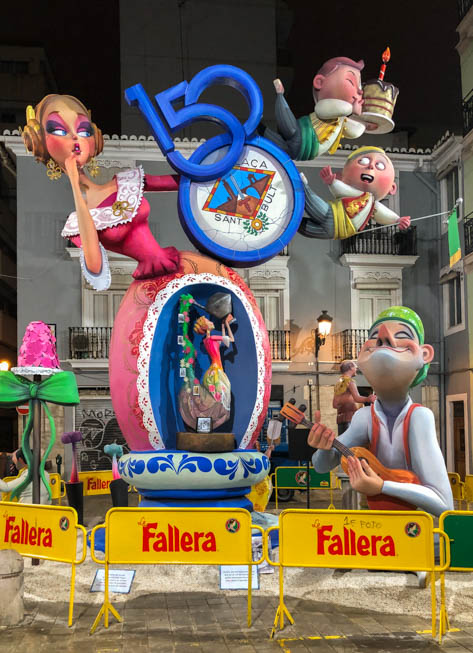
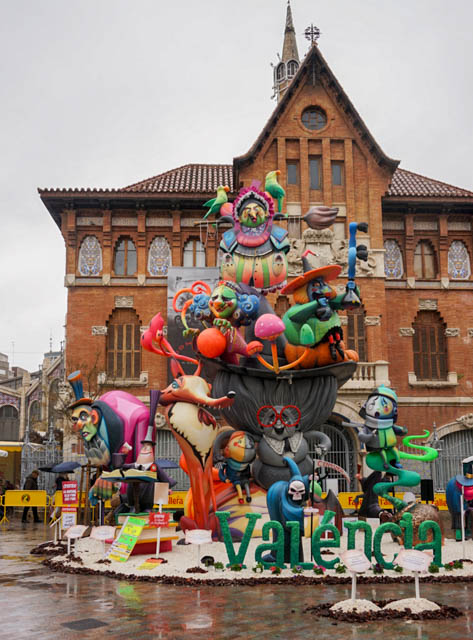
Why did Las Fallas originate❓
The profane origin of the Fallas dates back to the 18th century. It is actually linked to the custom of the carpenters’ guilds of stacking wood and old junk from their artisan workshops and setting those on fire in honour of their patron Saint Joseph (San José) just as winter ended and spring began. In the past, this festivity was also a way of preserving the Valencian language when it was prohibited.
Nowadays, the Fallas symbolize the coming of the new season as well as purification and rejuvenation.
As a deeply ingrained Valencian tradition, the know-how associated with the construction of the ninots for the fallas is transmitted within families, who often belong to different guilds among participating communities. Thus, this festivity provides an opportunity for collective creativity and the safeguarding of traditional arts and crafts. Thousands of people actively participate in this enormously popular festival. It is also a source of community pride that contributes to cultural identity and enhances social cohesion.
Of all the festivals and celebrations that take place in Valencia, the Fallas are undoubtedly the ones that have gained the most fame. In 2016, UNESCO recognized Las Fallas as an Intangible Cultural Heritage of Humanity.
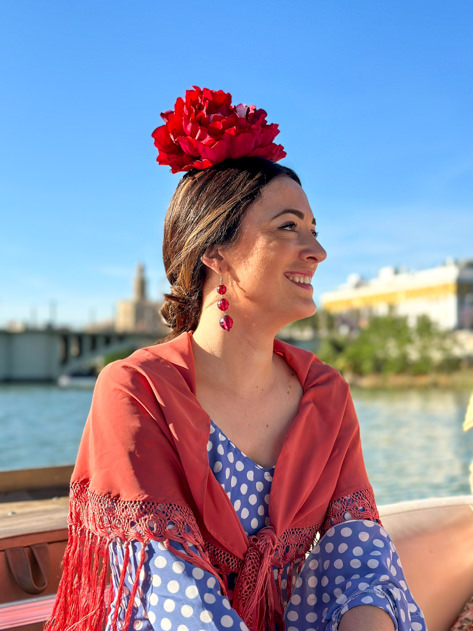
Learn more about these traditions around the world.
A guide to the Feria de Abril in Sevilla
The Alarde in Irún: ‘fiestas’ of San Pedro & San Marcial
The cheerful Carnival of Tarija
The story behind one of my favorite sweets: ‘opilla’
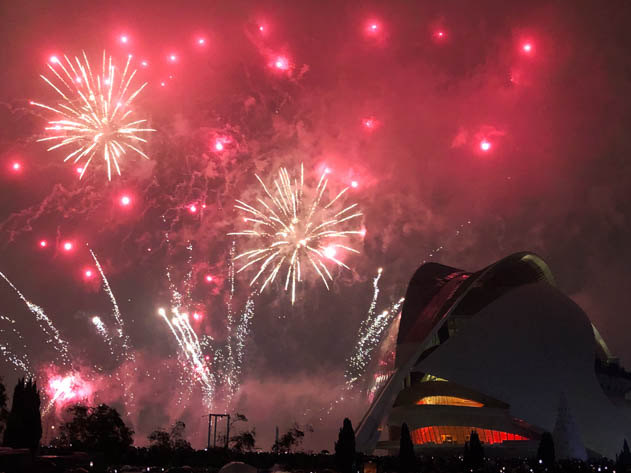
Where to see the Valencian Fallas festival? 📍
Following the plantá, you will find around 800 falla monuments scattered throughout the city of Valencia!
In addition to the towering monuments themselves, there are a number of key places you want to add to your Fallas itinerary to make sure you don´t miss a thing of this traditional festival.
- Calle de Colón: admire the Cabalgata del Foc, a light, fire and gunpowder show along this street starting at 19h on March 19th.
- Museo de las Ciencias: the Ninot Exhibition brings together the figures chosen by each Fallas commission in the hope that their ninot will be spared from the fire. This year, the exhibition will take place from January 31st until March 15th. During that time, the public can vote and eventually the two that received the most support will be saved from being burned on March 19th (known as ninots indultats). Book your tickets in advance to secure a spot while exploring the massive Ciudad de las Artes y las Ciencias, a futuristic architectural complex designed by Santiago Calatrava and Félix Candela and inaugurated in 1998. The Nit del Foc on March 18th typically takes place around the nearby Palau de Les Arts Reina Sofia as well.
- Plaza del Ayuntamiento: join the crowds at the Town Hall Square every day at 2pm from March 1st to March 19th while experiencing the noisy mascletá, a pyrotechnic show of firecracker detonations.
- Plaza de la Virgen: head to this iconic square in the city center as well as to its adjacent streets (Calle de San Vicente, Calle de la Paz) in the afternoon of March 17th and 18th to see first-hand how the falleras offer flowers to the patron saint of Valencia, the Mare de Dèu del Desamparats, during Ofrena de Flors.
- Torres de Serranos: come to these historic towers in El Carmen neighborhood on the last Sunday in February to hear a large number of falleras announce that the Fallas are around the corner. This event is known as crida, and it is then followed by fireworks.
In case you´re not in Valencia during the first half of March, don´t fret, I have you covered! Get a glimpse of the Fallas in the following museums. I know it´s not the same as being there in person, but still, it might do the trick. 😉
- La Ciutat Fallera: this district in the northwest of the city is where most of the figures for the Fallas celebrations are built and stored. Even though it is not properly a museum, events, exhibitions and workshops are held here throughout the year to promote the history and the Valencian tradition of Fallas.
- Museo Fallero: its permanent collection houses endless items related to the traditional Fallas, ranging from the large and children’s figures that were pardonned every year (‘ninot indultat´), to the posters announcing the festivities or the portraits of the Falleras Mayores of Valencia. It´s a great museum if you´re visiting with kids.
- Museo y Colegio del Arte Mayor de la Seda: dating from the 15th century, this prominent building housing the College of High Silk Art is the most ancient and extensive guild’s archive in Europe. In it you can admire the elaborate costumes of the Fallas female participants (falleras), who wear delicate silk tulles and embroideries.
Last but not least, let me mention that even though the Fallas de Valencia are the most famous, there are other destinations in the Valencian Community that also celebrate these festivities during the same period. These include towns in the Alicante, Castellón and Valencia provinces such as Alzira, Burriana, Denia, Gandía, Paterna, Sagunto, Torrent or Xátiva. It´s a good alternative if you have enough time and want to avoid the crowds in Valencia!
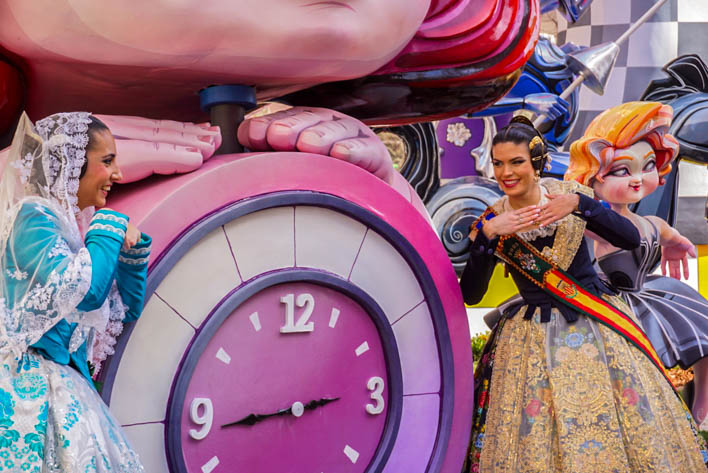
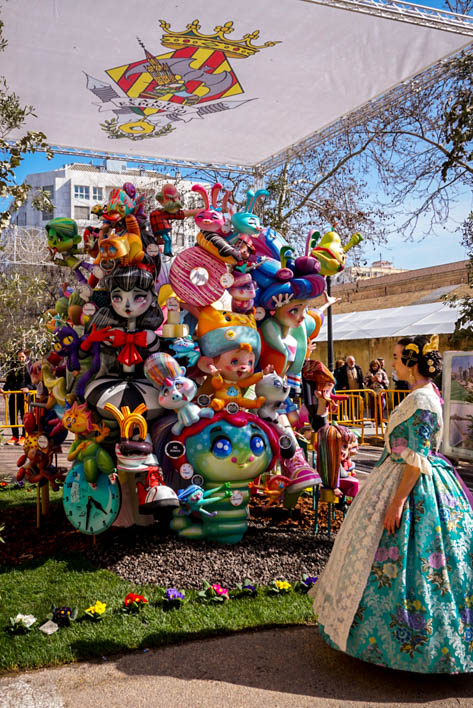
Who is who in the Fallas? 👥
As mentioned, the Fallas are an extremely popular undertaking, with thousands of locals involved in this celebration in one way or another.
That being said, let me highlight two key figures in the Fallas de Valencia.
On the one hand, there is the Comisión Fallera. These commissions bring together a compact human team (falleros and falleras) comprising all those who want to work side by side for a whole year so that the Fallas of their neighbourhood or association can be held. Typically, each commission works on both a large and a children´s falla (known as falla grande and falla infantil).
To give you an idea of the size of it all, there are almost 400 commissions in Valencia organized in 26 sectors corresponding to the various areas of the city! The Junta Central Fallera is the body responsible for organizing, managing and coordinating the Fallas festival in Valencia.
The falleros get together at the casal faller, the place where they decide about their falla monument and activities, hold social gatherings and meals throughout the year, and celebrate during the Fallas festival.
On the other hand, we have the falleras, the Fallera Mayor and her Corte de Honor. The abovementioned commissions are responsible for selecting the little girls and women who will represent their neighborhood or association. They would actually be the equivalent of our ´cantineras´ in the Alarde of Irún.
After a tight preselection and selection process, each commission chooses two falleras mayores (an adult and a child) as well as their courts of honour (Corte de Honor), a group of 12 young ladies for the older fallera and another of 12 girls for the child fallera mayor. Then, from among all of the commissions, the Fallera Mayor and the Fallera Mayor Infantil are proclaimed. This pair will have the honor of representing Valencian women for a whole year, while promoting this celebration and encouraging locals and visitors to take part. For example, Berta Peiró García was picked as the Fallera Mayor of Valencia for the 2025 Fallas.
The Falleras´ dresses and hairstyles deserve a special mention. These little girls and women are dressed with baroque, voluminous gowns typically made of silk or embroideries, representing the rich festive costumes of the farmers of the Valencian land. On top of that, they style their hair with elaborate buns.
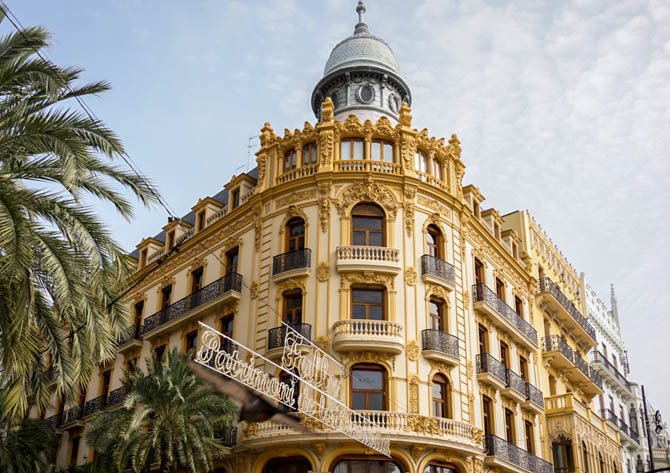
What to do in Valencia during the Fallas 🎆
In this section, I´ll be suggesting what to do during the vibrant Fallas festival in Valencia. I will also let you know about my own personal experience, and will share a few tips so you are aware of what to expect and can prepare your trip accordingly.
Here are my suggestions on what to do during the Fallas:
- First and foremost, walk around the busy streets to admire the creative, imposing Fallas monuments in order to appreciate their intricate details. This is best done by foot, although you can always take public transportation should you wish to visit some Fallas that may be further away.
- Embrace the noise, the gunpowder smell and the smoke because there´s hardly a way around it. 🙂 That being said, I´m sharing a few tips on this below.
- Enjoy the vibrant atmosphere on the streets of Valencia, from live bands playing pasodobles to endless street food stalls offering buñuelos, churros or paella. Be on the lookout for the traditional cercavila or passacarrer, a parade in which musicians play the dolçaina (a type of flute) and the tabal (a kind of drum).
- Learn about the fascination of Valencians with fire, firecrackers and fireworks. In Spain, Valencian fireworks are legendary and this industry is very powerful across the region. Visiting during the Fallas is a great opportunity to gain an understanding of the various types of firecrackers, from the popular tro de bac used during the despertàs, to the tro d’avís (the rocket that indicates that the mascletà is about to begin) or the terratrèmol (literally meaning earthquake and best known for its forceful sound). Stay aware of firecrackers though, since locals, especially kids, love throwing small firecrackers (petardos) in the streets. This experience is certainly not for the faint- hearted!
- Soak up this authentic experience! Be amazed by the elaborate Falleras´ costumes and hairstyles, a genuine cult of traditions. Their rich embroideries are a feast for the eyes!
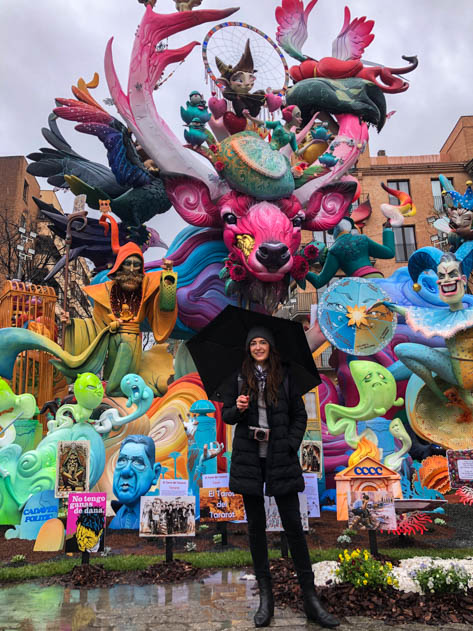
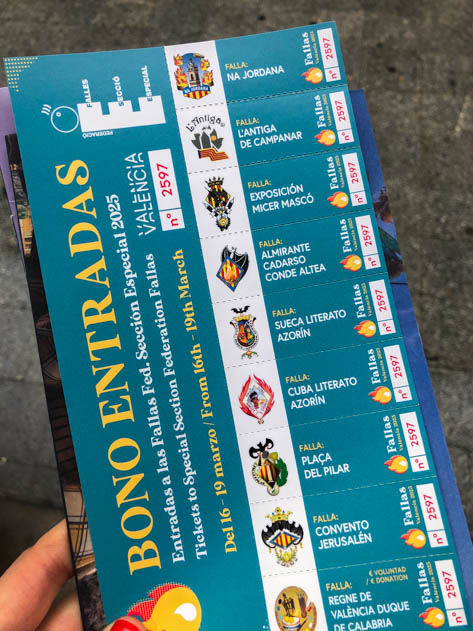
My experience during the Fallas festival in Valencia
As I expected, living the ‘Fallas’ festival in Valencia was a unique experience despite the unfortunate moody weather. Crowded and noisy for sure, but totally worth it!
These were my key takeaways after witnesssing this deeply ingrained tradition:
- This year was particularly emotional following the disastrous floods around Valencia last October. Unsurprisingly, many fallas alluded to this terrible event by showcasing people asking for help or covered in mud.
- I absolutely loved seeing the Fallas in person after years of only watching them on TV. They are absolutely breathtaking—not just as stunning works of art but also as towering, larger-than-life creations. I was especially amazed by their sheer scale, particularly those in the Sección Especial, and it felt like there was an impressive sculpture waiting around every corner. What really caught me by surprise was how intricate they were—not only in size but in design. I hadn’t realized that each Falla had two facades—a front and a back—allowing you to admire them from every angle, like a 360-degree masterpiece. Their clever, satirical themes made them even more entertaining to explore, adding an extra layer of meaning to their artistry. Out of the nine biggest fallas, Falla del Pilar was my favorite. It’s incredible to witness such a rich artistic and cultural tradition firsthand. We´re lucky to have a heritage as vibrant as this in Spain!
- I bought a 16 EUR ticket to access the nine Fallas competing in the Sección Especial. I highly recommend getting it for various reasons. First, because it saves you time and money since you don´t have to wait in line with other people around the fences that surround the monuments. Also, it´s cheaper than paying for separate tickets to visit each and every falla. Second, the fast-track access is a great way to admire the fallas close up at your own pace, which is welcome if you want to take pictures. Third, this special ticket comes with a useful map that helps you easily locate the fallas of the Sección Especial along with other ones.
- I enjoyed experiencing the major events of the Fallas. That being said, it was exhausting because I walked a lot and I also had my fair share of standing for hours waiting for the mascletà, the cremà or La Nit del Foc to begin.
Feeling adventurous? Check out these outdoor activities with Manawa in Valencia.
Boat Rental without Licence from Valencia Marina
Canyoning on the ravine of Anna, Valencia
Excursion by jet ski in the Malvarrosa Bay, Valencia
Private Boat Tour from Valencia Marina
Stand Up Paddle Rental in Valencia
Via ferrata of Fuente Godalla in Enguera, near Valencia
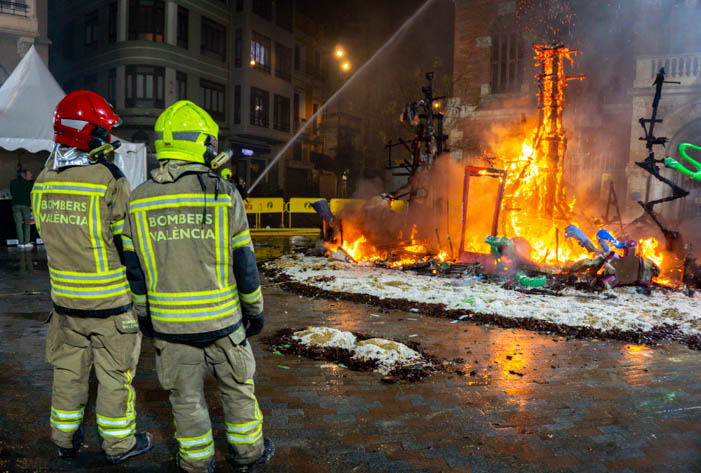
Fallas travel tips
In case this is your very first time visiting the Fallas in Valencia, here are a few tips to help you navigate this fascinating festival.
- 🗓 Book early: being an early bird really pays off if you´re considering visiting Valencia during the famous Fallas. This is the busiest time of the year in the city, thus accommodation and flight prices tend to skyrocket during this period. Even though I had booked my plane tickets well in advance, I had a hard time finding where to stay in town because hotels fill up months in advance. Luckily, I was able to secure four nights in a bunk bed in a female dormitory room at River Hostel for 271.8 EUR, including breakfast. I had a great stay here and their central location close to the Turia Gardens was all I could ask for, even though some facilities were a bit run down and I didn´t get to sleep much.
- 👟 Bring comfortable shoes because you are likely to be walking a lot while checking out the various fallas throughout the city. Also, expect big crowds and many streets being blocked. Hence, avoid driving and use public transportation instead, or simply walk.
- 💤 Don’t expect to sleep much, especially if you’re staying in the city center! Falleros play music and parade until past midnight, and many major activities such as the fireworks or the cremà take place at night.
- 👣 Explore off the beaten track: given that March 19th is a holiday not only in the Valencian Community but throughout Spain, it is very likely that the streets of Valencia will get VERY busy during the Fallas. That is why I suggest that you combine your visit to the city with other nearby destinations that also celebrate their Fallas to avoid the crowds. Alzira, Burriana, Denia, Gandía, Paterna, Sagunto, Torrent or Xátiva in the Alicante, Castellón and Valencia provinces are excellent alternatives.
- 💬 Language: most people in Valencia speak both Spanish and Valencian, which is a local dialect similar to Catalan or Majorcan. Expect locals in touristy spots such as major attractions, hotels and restaurants to speak decent English too. That being said, the vast majority of signs in the bigger fallas will be in Valencian, which might make it difficult to decipher.
- 📰 Local tips: to stay up to date with the latest news during the vibrant Fallas, I recommend you follow Valencia Secreta and Visit Valencia on social media.
- 🛟 Safety and security: Valencia is a safe city overall, but watch out for pickpockets in tourist areas or places that are particularly crowded. Given the overwhelming number of visitors who visit the city during the Fallas, beware of flocks of people, be mindful and try to take it easy. Also, remember to open your mouth during the ‘mascletá‘ to help prevent ear damage. Covering your mouth and nose with a handkerchief to avoid inhaling smoke is also a good idea. Since the Fallas are all about firecrackers, fireworks, detonations and fire, security is of the outmost importance too. That is why you will find security perimeters and hordes of firefighters around the key spots, be it Plaza del Ayuntamiento during the daily mascletás or Palau de les Arts during Nit del Foc. For extra peace of mind when traveling abroad, you can calculate how much you would pay for your health insurance with the SafetyWing widget below.
What to eat during the Fallas de Valencia: buñuelos, horchata and much more 🍽
Food plays a key role in the Fallas of Valencia. That is why you will stumble on endless street food stalls offering buñuelos, churros or paella.
During the Fallas, the most traditional food item that locals have is hot chocolate served with pumpkin fritters (buñuelos de calabaza or bunyols in Valencian). I actually had some while waiting for the cremà and they were delicious.
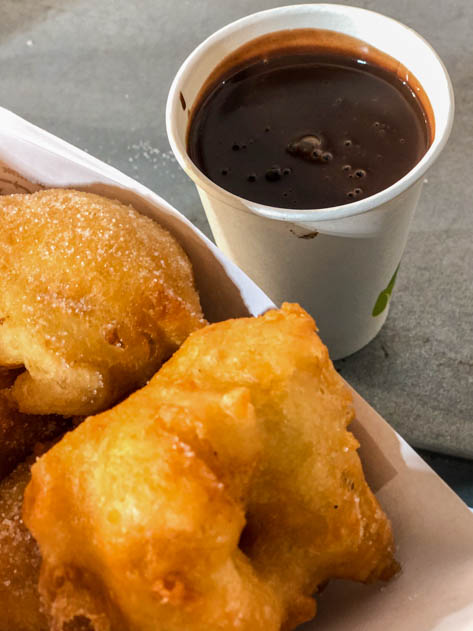
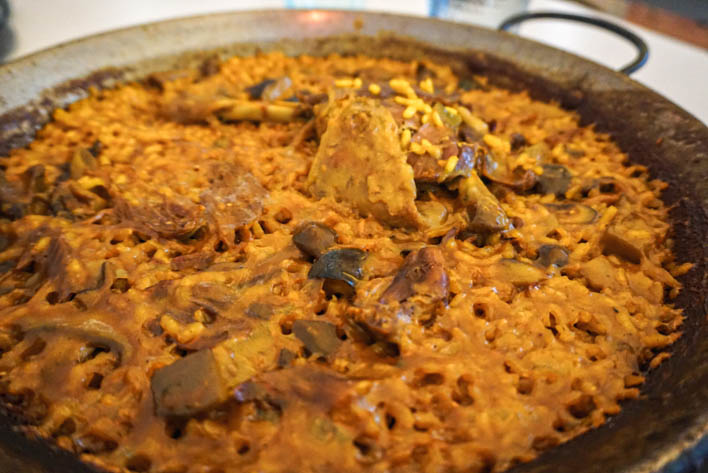
Another must-try in the sweet category includes tiger nut milk (horchata de chufa), which originates from nearby Alboraya and can be served liquid (líquida), slush (granizada) or mixed (mixta) along with long cakes covered in sugar (fartons).
Last but not least, outdoor meals and massive paella festivals are held on the streets or near the casals fallers.
Enjoy tasting these delicacies during the Fallas and thank me later! 😋
Do you like my content? Subscribe to my newsletter to stay tuned.
Valencia travel guide 🗺
As the capital of the Valencian Community and Spain’s third-largest city, Valencia (also known as València) offers a fascinating blend of historical heritage, modern architecture, vibrant culture and world-famous food thanks to the famous ‘paella‘. Located along the Mediterranean coast, this town is perfect for those looking to enjoy pleasant weather all year round.
Even though the Fallas provide a unique opportunity to discover this fascinating tradition, note that this might not be the best time to visit the busy city center of Valencia, which will be most likely crowded with locals and visitors alike. That being said, you can always explore other areas off the beaten track such as the fishing district of El Cabañal-Cañamelar, the neighborhoods of Extramurs and Eixample or La Albufera while catching a glimpse of the popular Fallas.
Check out my travel guide to learn about the top things to do in Valencia, from the ten must-do attractions to lesser known hidden gems, including what to see and do, what and where to eat, and where to stay. At the end, I’ve also included a map so you can easily pinpoint all the places mentioned throughout the post.
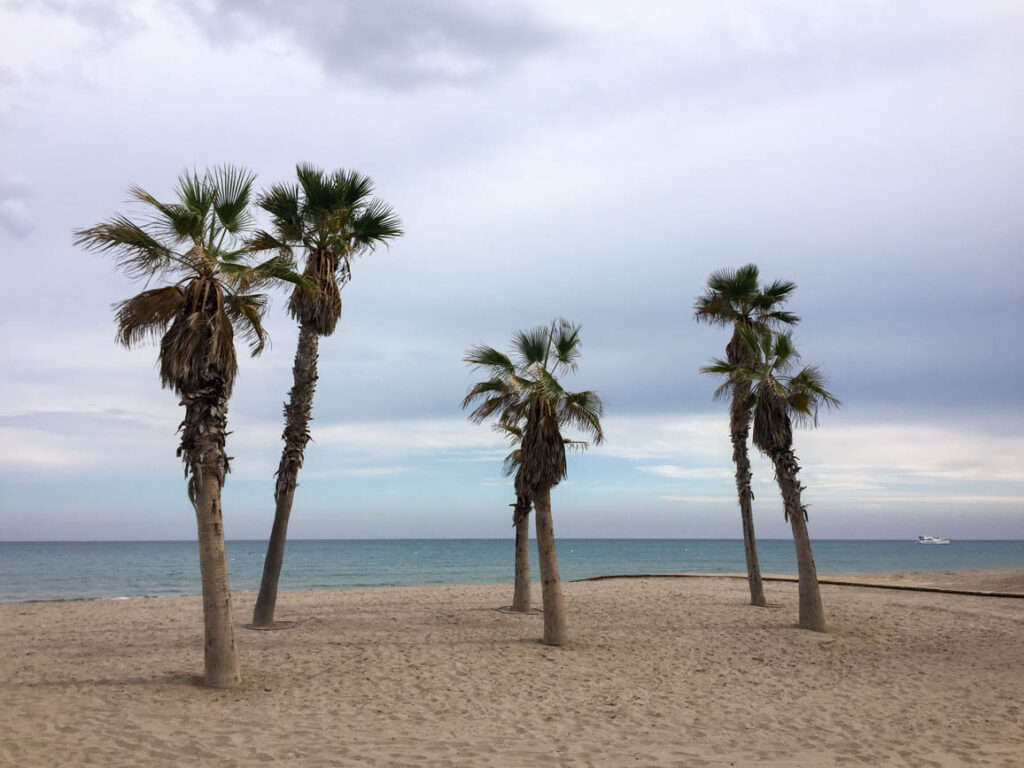
Day trips from Valencia 🧳
The coasts of this region are highly popular summer resorts for both Spaniards and foreigners, even though the balmy weather guarantees a sunny stay virtually all year round.
Lying by the Spanish Mediterranean shores, the southeastern Valencian Community encompasses three provinces. Going north to south, these are namely Castellón, Valencia and Alicante, named after their homonymous capital cities.
If you´ve had enough of the Fallas in Valencia, you may want to explore other nearby destinations on a day trip:
- Alicante province: refer to my section on ´Day trips from Alicante´ to get inspired. A few day trip ideas include the Costa Blanca (Altea, Benidorm, Calpe or Denia), although the tranquil inland villages are worth visiting too.
- Castellón province: explore Burriana to see Fallas off the beaten track, the capital city of Castellón de la Plana or the touristy Peñíscola.
- Valencia province: see my section on ´Day trips from Valencia´ for more ideas including Buñol, Gandía, Oliva or Xàtiva.
Read these posts for more inspiration around the Valencian Community!
Things to do in Alicante (travel guide & map)
Top things to do in Valencia: travel guide + map
All in all, Las Fallas is not just a festival—it’s a full sensory experience. From the deafening mascletàs to the mesmerizing fire displays, the vibrant traditions, and the delicious food, this is a celebration unlike any other. Whether it’s your first time or your tenth, Valencia’s biggest fiesta will always leave you in awe.
I hope that you enjoyed reading about the traditional festival of the Fallas in Valencia. Have you experienced Las Fallas before? Let me know in the comments! Or if you’re planning your trip, feel free to ask me anything!
***
✈️ Curious to know where I’ll be traveling next? ✈️
Stay tuned by following me on social media (Facebook, Instagram, X) and subscribe to my newsletter for regular updates!
In the meantime, safe travels around the world!
***
| GET READY FOR YOUR NEXT TRIP! |
|---|
| Browse my travel resources page to plan your upcoming trip. |
| Feeling adventurous? Book any outdoor activities worldwide with Manawa! |
| Get medical or health insurance via SafetyWing for extra peace of mind. |
| Looking for sports equipment? Feel free to browse my Decathlon profile for inspiration. |
| Use the comprehensive and helpful Anaya Touring or Lonely Planet travel guidebooks to plan your trip. |
| Book memorable activities and tours around the world with Get Your Guide. |
| Use your Revolut Card to pay in local currency when you’re traveling abroad! |

